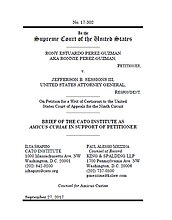Learn more about Cato’s Amicus Briefs Program.
One federal statute says that Rony Estuardo Perez-Guzman, who claims refugee status, isn’t eligible for asylum. Another one says that he is. Whose duty is it to reconcile this glaring legislative contradiction, and how should it be remedied? Mr. Perez-Guzman fled to the United States to escape violence and persecution in Guatemala. He was stopped by border patrol agents and deported, but reentered the United States because he still feared for his life. The asylum statute (8 U.S.C. § 1158) guarantees the right of “any alien … physically present in the United States … irrespective of such alien’s status” to apply for asylum. The reinstatement statute (8 U.S.C. § 1231) states that an individual who has previously been removed from the United States “may not apply for any relief under this chapter” (which includes asylum). The U.S. Court of Appeals for the Ninth Circuit held that the two statutes conflict — so far so good — and are therefore are ambiguous, which is where the judicial mischief starts. A finding of statutory ambiguity often leads courts to simply defer to administrative agency interpreting the statute, which here means the Justice Department refusal to let Perez-Guzman apply for asylum. Perez-Guzman has petitioned the Supreme Court to review his case. Cato has filed an amicus brief supporting that petition and challenging the lower-court holding that statutory conflict triggers Chevron deference (named after the 1984 Supreme Court case that created the doctrine). Chevron deference provides that courts must defer to administrative agency interpretations of the authority granted to them by Congress (1) where the intent of Congress is intentionally ambiguous and (2) where the interpretation is reasonable or permissible. The Court has curtailed Chevron by carving out important limitations, which mean that Chevron deference will not apply without an implicit congressional delegation for an agency to “fill in the gaps” in ambiguous statutory language. The notion that Congress intentionally drafts ambiguous language so an agency may interpret that language as it sees fit is itself suspect as a matter of the separation of powers: our Constitution doesn’t allow a delegation of legislative power to the executive. But the notion that Congress commits that same folly by drafting directly conflicting statutory language is ludicrous. The Administrative Procedure Act mandates that courts interpret statutory provisions and determine the applicability of agency actions; it attempts to reinforce the importance of the separation of powers. Chevron asks us to forget all about it. Expanding the doctrine further, to incorporate not just ambiguous statutes but conflicting ones will further erode the rule of law. If the Court wants a way to resolve these conflicting statutes, it should look to the “rule of lenity.” It provides that in construing ambiguous criminal statutes, courts should resolve the ambiguity in favor of the defendant. The rule is also applied in deportation statutes. It reflects the fundamental principle that Congress must speak clearly if it wants to impose on an individual an especially severe deprivation of liberty — which deportation most assuredly is. When removal from the country is at stake, courts shouldn’t defer to an agency interpretation that commands a greater infringement on liberty than a statute requires (however restrictive or expansive that statute may be). The Supreme Court should review Perez-Guzman v. Sessions, restore the balance of constitutional power, and reclaim the judiciary’s authority to say what the law is.
